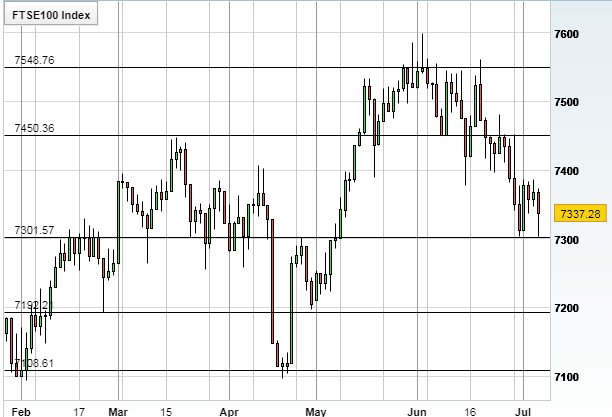How vulnerable is FTSE 100?
7th July 2017 10:01
by Lee Wild from interactive investor
Share on
It started well, but optimism faded fast in London this week. Now, since peaking just a point shy of 7,600 early last month, the is in danger of making a fifth consecutive week of losses.
And that's despite news of a merger between credit card firm Vantiva and blue-chip that popped the payments technology provider 16% higher. It had been more before potential rival bidder JP Morgan pulled out.
Mining heavyweight has had a good run, too, first upgraded to 'buy' at UBS a month ago and again this week by Deutsche Bank with price target of 1,600p. The company offers a prospective yield of over 6%, tempting traders to pick up stock.
Peers , and are also in demand. The former has just been added to Barclays' European Equity Strategy portfolio after positive data out of major commodities consumer China.
And, after a wobble in recent weeks, the housebuilders are back in favour following a string of decent updates from key players. has done best in the past few days after revealing increases in legal completions, average selling prices and revenue during the past six months.
Others have performed well, including lenders and , but there have been notable losers, too.
Investors heard of bad news for the UK service sector, which we heard slowed last month, and the worst number of business optimism since the EU referendum.
The latest services purchasing managers' index (PMI) fell from 53.8 to 53.4, not much of a dip and still above 50, the level which indicates growth, but it is a concern.
"Most striking…was marked declines in new business and business expectations on elevated domestic political and Brexit-related uncertainties," say economists at Barclays.
"Overall, the fall in forward-looking components does not bode well for future output in Q3 and Q4 of this year, but is in line with our view of bleak growth for H2 17."

A look at the FTSE 100 chart above shows how technical support kicks in at around the 7,300 level. Drop much below that and analysts say the risk of a further 100-point fall increases sharply.
We've talked about whether this is the start of a wider market sell-off, the much feared correction which is, of course, inevitable at some point. But it's unclear if this is it.
Markets always pull back until they find the right level – where buyers decide that share valuations more correctly reflect current levels of profit growth. And there are buyers around.
What will cause more dramatic declines is some kind of shock. We know where it could come from – China, Trump, Brexit, slower growth, inflation, North Korea... take your pick. Volumes typically slow down over the summer, too, with a lack of liquidity potentially causing sharper market swings than we might otherwise expect.
So, plenty to watch out for as the weather improves, but the decline from the June high is currently limited to 300 points, or 4%. Not chicken feed, exactly, but hardly enough to set alarm bells ringing.
This article is for information and discussion purposes only and does not form a recommendation to invest or otherwise. The value of an investment may fall. The investments referred to in this article may not be suitable for all investors, and if in doubt, an investor should seek advice from a qualified investment adviser.